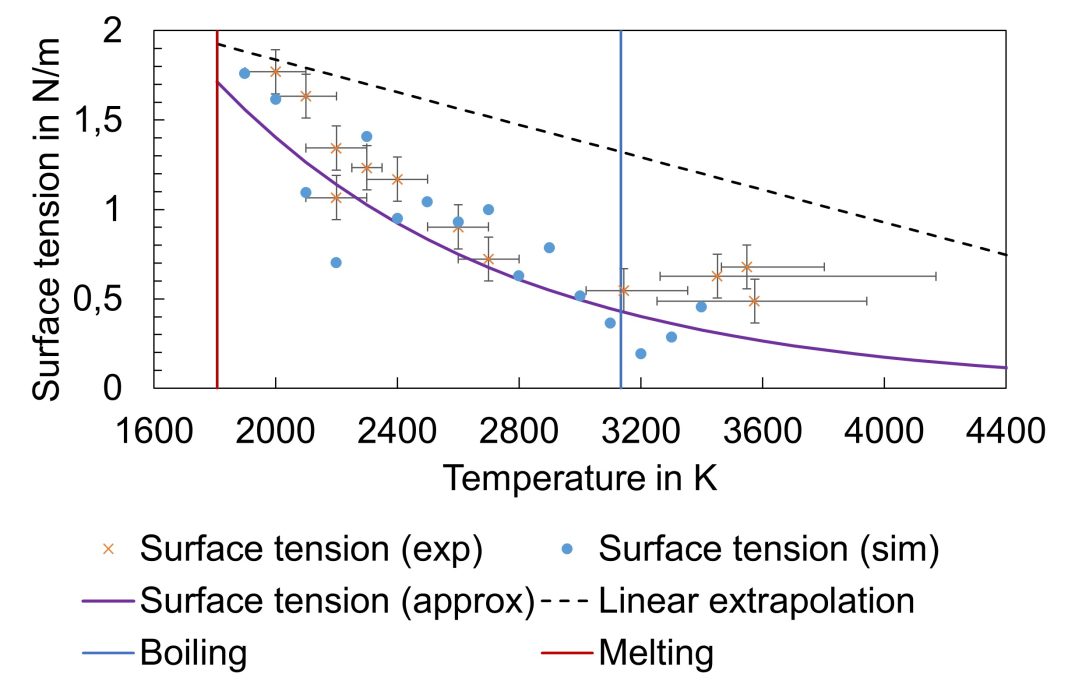Prof Dr-Ing. Jörg Volpp, Associate Professor from University West, Trollhättan, Sweden, states that understanding metal surface tension at high temperatures will increase process understanding to benefit European Union metal processing and manufacturing industries
Many thermal manufacturing methods require heating the materials to high temperatures. Those processes are essential to produce metal parts and components for our modern society. The process outcomes depend on the material properties of the metals, e.g., in casting, welding, brazing, cutting, or Additive Manufacturing (AM).
Although those manufacturing methods are used, their complexity often requires extensive process control and material testing to ensure quality. The fluid dynamic effects of overheated molten metals can affect the material properties after solidification, defect formation, and geometrical precision of the parts.
Therefore, a better understanding of the material properties can help to reach a more efficient material processing at higher and predictable quality, which promises to save resources and energy.
Additive manufacturing
Important manufacturing methods that will benefit from increased knowledge about high-temperature material properties are AM techniques, which are increasingly used within Industry 4.0. AM enables the production of parts with lightweight designs and complex, customisable features, which will be necessary for the efficient use of resources on our planet.
Metal 3D printing is based on generating a metal melt pool and incorporating additional material to build structures both for Directed Energy Deposition (heat sources: laser beam or arc) and Powder Bed Fusion Processes (heat sources: laser or electron beam). The metal surface is locally heated to temperatures above melting temperatures (e.g., iron ~1538 °C), sometimes close or even above boiling temperatures (iron: 2861 °C). This means that the formation of the material within the new structure happens at high temperatures.
However, many material properties are unknown in those conditions, and the creation mechanisms of defects like spatters or porosity are not well understood yet but are highly relevant to achieving high-quality outcomes. In addition, material properties after cooling depend on the thermal history that the material experienced, which requires knowledge about material behaviour and thermal management and control.
Surface tension
Many high-temperature processes depend on the surface tension of the material. Surface tension is a force in the surface direction that tends to act like a skin holding the material together. The effect might be known from the possibility for insects to walk on water. A change of surface tension, e.g., adding oil to the water, makes them sink.
For high-temperature metal processes, surface tension defines the formation of droplets, bubbles, and pores and the spreading behaviour of structures. Since surface tension is such a relevant parameter, increased knowledge is necessary. Surface tension depends on the temperature, the material used, and the alloying elements, making a precise measurement or theoretical prediction challenging.
Measuring surface tension of metals
There are many methods to measure surface tension. However, at high temperatures of metals, several methods cannot be used. Contact methods can fail at such high temperatures and conditions of constant surface temperatures are difficult to realise.
Therefore, material research was funded by Vetenskapsrådet (The Swedish Research Council) to explore new ways of gaining insight into the high-temperature surface tension of metals. Surface wave measurements induced by a high-intense laser illumination were suggested to derive surface tension values. The laser beam is a great tool to induce different melt surface temperatures. (1) Like throwing a stone into water and observing the radial waves, waves were observed on liquid metal surfaces. The frequency and wavelength of those waves are related to the surface tension. Using a high-speed camera and parallel temperature measurements, surface tension values were obtained and related to the actual temperature.
Surface tension at increasing temperature
Based on measurements and theoretical derivations of surface tension at and just above melting temperatures, the literature suggests that a linear decrease of surface tension is expected at increasing temperatures. This assumption would mean that surface tension disappears at some point. Therefore, experimental and theoretical works were conducted to clarify the surface tension behavior at higher temperatures.
Surface wave measurements show that surface tension values around the melting point can be validated by literature data (Fig. 1). However, when increasing the temperature above the melting temperature, surface tension values are lower than the literature would suggest. The decrease in surface tension seems to be steeper. However, the decrease appears not to be linear. Even around boiling temperature, surface tension could still be measured. This indicates that the surface tension does not disappear. (2) Based on those measurements below boiling temperature, an exponential decrease was suggested as an empirical description of surface tension.
To better understand the reason for this trend, a simplified atomic model was built based on the arrangement of liquid iron atoms in a cube lattice. A simple Lennard-Jones interaction was assumed. The interactions between the atoms position the atoms, and the forces between the surface atoms give an indication of the surface tension.
Even though the model contains simplifications and assumptions, the general trend of the surface tension was calculated comparable to the experimental measurements (Fig. 1). Simulation results indicate that the reduction of the strength of interaction between the atoms has a larger decreasing impact on the surface tension at increasing temperatures and that at least two atomic layers contribute to the actual surface tension at elevated temperatures of steel. (3)
Understanding the precise behavior of molten metal at high temperatures can improve the part properties and increase the competitiveness of European Union industry.
Acknowledgements:
Vetenskapsrådet (The Swedish Research Council), SMART – Surface tension of Metals Above vapoRization Temperature (2020–04250)
References:
- J Volpp, High-Power Laser Material Processing for Engineers, 2024, CRC Press.
- J Volpp, Surface tension of steel at high temperatures, SN Applied Sciences, 2023, 5(9), 237. DOI: https://doi.org/10.1007/s42452-023-05456-y
- J Volpp, Surface Tension Estimation of Steel above Boiling Temperature, Applied Sciences, 14(9), 2024, 3778.


